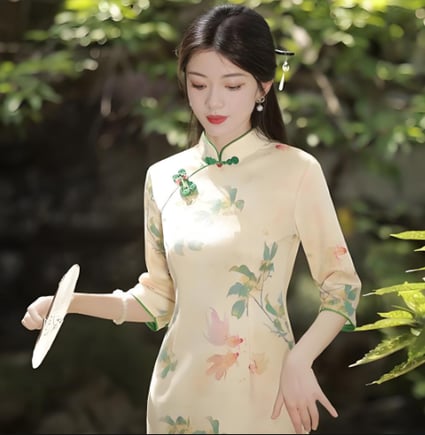How to wear a qipao
This article will introduce how to wear cheongsam, including choosing the right style according to body shape, choosing the right style according to the occasion, choosing the right accessories and hairstyle, and how to maintain an elegant walking posture and manners.
QIPAO KNOWLEDGE
6/6/20252 min read


Choosing the right version is the key
Qipao pays attention to fit, but it does not mean tight. Traditional qipaos are mostly straight-tube, suitable for people with slim figures and straight shoulders; modified qipaos pay more attention to fitting the body curve, and the modification of waist and chest lines is more modern. Pear-shaped figures are suitable for A-line hem styles, and women with a slight belly can choose high-waisted cuts or slightly elastic fabrics, which have a sense of lines but do not tighten the flesh.
The general principle is: qipaos should be "fitting" but not "tight", and should be "wrapped" but not "bound". Fit is the basis of beauty, not a penalty for size.
Occasions determine style
Qipao is a dress in formal occasions and an attitude in daily life. High-end materials such as silk, satin, and hand-embroidery are suitable for dinner parties, weddings, ceremonies, and other occasions, and they are matched with stilettos and buns; for daily gatherings or artistic occasions, you can choose more life-like designs such as cotton and linen, improved stand-up collars, and printed patterns.
Don't force "retro" in inappropriate occasions, otherwise it will easily cause an unnatural sense of disobedience. The logic of wearing qipao should be "integration" rather than "outstanding".
Accessories and hairstyles determine the overall temperament
The sense of detail of qipao comes from accessories. Earrings, handbags, thin-strap watches, and small hairpins can all be the finishing touch. But be sure to avoid "stacking": qipao itself is the visual focus, and accessories should not be too eye-catching.
In terms of hairstyle, traditional buns and Chinese-style buns are preferred. You can also choose modern styles such as side-parted big waves and low ponytails according to the overall style, but try to avoid messy or too sporty styles to avoid conflicting with the restrained atmosphere of qipao.
Walking posture and manners are the "invisible structure" of qipao
No matter how expensive a qipao is, it is difficult to support its beauty without an elegant posture. When walking in a qipao, try to keep your shoulders naturally back, your back straight, your steps small and steady, your knees not higher than your feet, and your legs together when sitting down, and it is okay to lean slightly. qipao is a dress that emphasizes "inward aura". Too much posture and too much emotion will destroy its charm.
This is not artificial, but the qipao's requirement for the wearer to be "consistent inside and outside". When wearing it, you need to be a little restrained and calm.
Temperament is the final answer to wearing a good qipao
People who really wear qipaos well are often not because they have the most perfect figure, but because they have a kind of calm, restrained and confident beauty. This temperament can be the accumulation of reading, the training of aesthetics, or your insistence on "beauty". The qipao is ultimately worn by yourself.
So, before choosing a qipao, ask yourself what you want it to express. Is it gentle or firm, traditional or modern, graceful or flamboyant? When you treat it as a style rather than just clothes, it will truly blend with you.
Qipao is not only a piece of clothing, but also a manifestation of cultural temperament. From the modern style that was popular in Shanghai in the 1930s to the contemporary design language that integrates fashion elements, the charm of qipao lies in the gentleness, delicacy and strength of oriental women. However, many people have misunderstandings about "how to wear a qipao". If you don't wear it well, you will look restrained or too artificial. If you want to really wear a temperament, you need to work hard in the following aspects.


